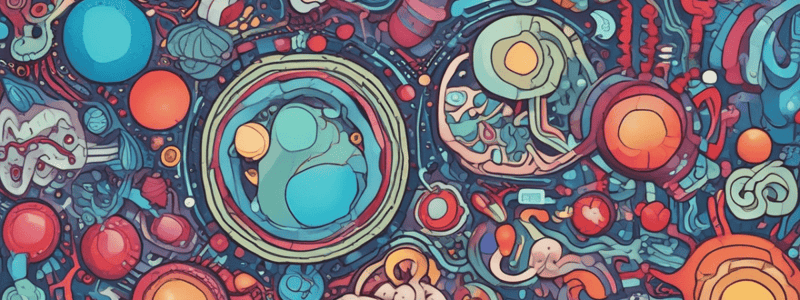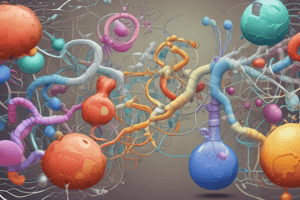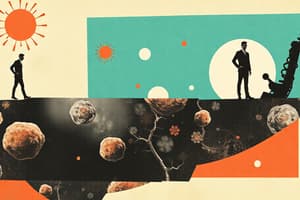Podcast
Questions and Answers
What is the primary reason why there is no 'storage' form of protein in the body?
What is the primary reason why there is no 'storage' form of protein in the body?
- The body has a limited capacity to store protein
- Protein is rapidly catabolized and excreted as urea
- Protein is not essential for human health
- Protein is needed to replace lost amino acids and allow for tissue repair (correct)
What is the recommended daily intake of protein?
What is the recommended daily intake of protein?
- 50 – 70 g per day (correct)
- 100 – 150 g per day
- 70 – 100 g per day
- 30 – 50 g per day
What happens to surplus amino acids in a well-fed individual?
What happens to surplus amino acids in a well-fed individual?
- They are converted into energy
- They are used to synthesize other nutrients
- They are stored in the body for later use
- They are rapidly catabolized and the nitrogen is excreted as urea (correct)
Which of the following amino acids can be synthesized by humans?
Which of the following amino acids can be synthesized by humans?
What is the state of nitrogen balance when the amount of nitrogen taken in equals the amount of nitrogen excreted?
What is the state of nitrogen balance when the amount of nitrogen taken in equals the amount of nitrogen excreted?
What is the consequence of prolonged negative nitrogen balance?
What is the consequence of prolonged negative nitrogen balance?
In which of the following conditions is positive nitrogen balance commonly seen?
In which of the following conditions is positive nitrogen balance commonly seen?
What is the consequence of high protein intake in a well-fed individual?
What is the consequence of high protein intake in a well-fed individual?
What is the primary role of the ubiquitin breakdown system in cellular protein regulation?
What is the primary role of the ubiquitin breakdown system in cellular protein regulation?
What is the fate of most amino acids after losing their amino groups during transamination and deamination?
What is the fate of most amino acids after losing their amino groups during transamination and deamination?
Which of the following amino acids can only be degraded to acetyl CoA?
Which of the following amino acids can only be degraded to acetyl CoA?
What is the role of cortisol in protein degradation?
What is the role of cortisol in protein degradation?
What is the process by which cells take in foreign proteins or damaged organelles?
What is the process by which cells take in foreign proteins or damaged organelles?
What is the primary fate of the carbon skeletons of 13 amino acids during starvation?
What is the primary fate of the carbon skeletons of 13 amino acids during starvation?
What happens to the amino groups of amino acids in the liver?
What happens to the amino groups of amino acids in the liver?
Which amino acid is a safe carrier of ammonia in the blood stream?
Which amino acid is a safe carrier of ammonia in the blood stream?
What is the result of impaired conversion of NH3 to urea?
What is the result of impaired conversion of NH3 to urea?
Which of the following is NOT a product of nitrogen metabolism?
Which of the following is NOT a product of nitrogen metabolism?
What is the primary function of the liver in nitrogen metabolism?
What is the primary function of the liver in nitrogen metabolism?
Which amino acid can be converted into glucose?
Which amino acid can be converted into glucose?
What is the consequence of ammonia toxicity in the brain?
What is the consequence of ammonia toxicity in the brain?
What is the name of the cycle that converts ammonia into urea?
What is the name of the cycle that converts ammonia into urea?
What is the average daily protein turnover in an adult?
What is the average daily protein turnover in an adult?
What is the primary role of amino acids in the body?
What is the primary role of amino acids in the body?
What is the term for the process of converting an amino acid into a keto acid, releasing ammonia in the process?
What is the term for the process of converting an amino acid into a keto acid, releasing ammonia in the process?
What is the significance of the classification of amino acids as essential or non-essential?
What is the significance of the classification of amino acids as essential or non-essential?
What is the term for the process of transferring an amino group from one amino acid to a keto acid, resulting in the formation of a new amino acid and a keto acid?
What is the term for the process of transferring an amino group from one amino acid to a keto acid, resulting in the formation of a new amino acid and a keto acid?
What is the term for the balance between the amount of nitrogen ingested and the amount of nitrogen excreted in the body?
What is the term for the balance between the amount of nitrogen ingested and the amount of nitrogen excreted in the body?
What is the term for the process of degrading proteins into amino acids?
What is the term for the process of degrading proteins into amino acids?
What is the significance of glutamate, glutamine, aspartate, and alanine in amino acid metabolism?
What is the significance of glutamate, glutamine, aspartate, and alanine in amino acid metabolism?
Flashcards are hidden until you start studying
Study Notes
Protein Turnover and Amino Acid Pools
- Body proteins are continuously degraded to amino acids and re-synthesized, with an average turnover of 300-400g per day in an adult
- Most proteins have half-lives of several days, while structural proteins like collagen may have half-lives of years
- Hormones and digestive enzymes are degraded very rapidly, with half-lives of minutes
- The amino acid pool consists of free amino acids in very low concentrations inside cells or in the bloodstream
- Amino acids in the pool mix and exchange with other free amino acids distributed throughout the body
Nitrogen Balance
- Nitrogen balance is a state where the total amount of nitrogen taken in the diet as protein is equal to the amount of nitrogen excreted from the body
- Positive nitrogen balance occurs when protein synthesis exceeds the rate of breakdown, and is seen in normal growth in children, convalescence after serious illness, and pregnancy
- Negative nitrogen balance occurs when protein breakdown exceeds synthesis, and is seen in starvation, serious illness, and injury
Classification of Amino Acids
- There are 20 amino acids commonly found as building blocks of proteins
- Humans can synthesize only 10 amino acids from other intermediates, and rely on dietary sources for the remaining essential amino acids
- Essential amino acids include valine, methionine, histidine, lysine, phenylalanine, leucine, isoleucine, and threonine
Pathways of Protein Degradation
- Most cellular proteins are removed by the ubiquitin breakdown system
- Foreign proteins and old or damaged subcellular organelles are taken into vesicles by endocytosis or autophagocytosis, and then degraded by proteolytic enzymes in lysosomes
Transamination and Deamination
- Transamination involves the transfer of the amino group of an amino acid to an acceptor molecule, such as 2-oxoglutarate, resulting in an oxo acid and glutamate
- Deamination involves the release of the ammonia group as ammonia (NH3) or ammonium ions (NH4+)
Amino Acid Metabolism
- The liver plays a central role in nitrogen metabolism, removing amino acids, glucose, and fats from the portal blood supply
- The liver is responsible for the synthesis of cellular proteins, plasma proteins, haem, purines, and pyrimidines
- The liver also degrades excess amino acids by trans-deamination and converts NH3 to urea for excretion
- Glutamine is an important amino acid in the inter-organ transport of nitrogen, carrying amino groups to the liver for urea formation
The Urea Cycle
- The urea cycle (ornithine cycle) is responsible for the excretion of excess nitrogen in the form of urea
- The end products of nitrogen metabolism include urea, creatinine, uric acid, and ammonia
- Impaired conversion of NH3 to urea can lead to hyperammonaemia, which can cause cerebral oedema, coma, and death
Studying That Suits You
Use AI to generate personalized quizzes and flashcards to suit your learning preferences.




